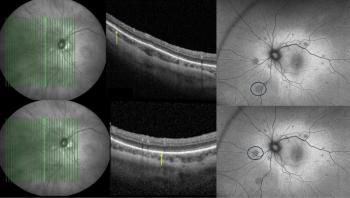
Use of virtual reality training in amblyopia
Virtual reality dichoptic and perceptual learning training seem to be a useful therapeutic option for achieving a successful visual rehabilitation in amblyopic patients.
Amblyopia is a visual developmental disorder consisting of a reduced best-corrected visual acuity in one or, rarely, both eyes without the presence of any ocular pathology1. The aetiology is often a high refractive error, anisometropia, strabismus or a combination of these factors.
Neurological research in recent years has led to a better understanding as to the mechanisms underlying the visual loss in this condition1. Specifically, many monocular and binocular visual deficits have been shown to be the consequence of the anomalies in the visual pathway of the amblyopes, mainly in the striate and extra-striate cortex2.
Amblyopic eyes showed worse neural adaptation in V1, V2, V3, V3a, Vp and V4; decreased neural response assessed by functional magnetic resonance imaging;3 and worse effective connectivity between the implied brain regions4. For this reason, visual training has been investigated in recent years to confirm whether it might be an effective option for restoring vision in amblyopic patients5, including computer-based active visual training, such as the use of perceptual learning environments, dichoptic stimulation and virtual reality (VR)1.
Several validated video games have been developed that use visual and perceptual tasks, such as orientation discrimination or letter recognition, among others, to cause a response in neuro-modulatory pathways and the enhancement of attentional skills, according to neurophysiological studies1. These options may support and optimise treatments with spectacles, patching and penalisation.
Benefits of virtual reality
Among the more recent products resulting from the evolution of digital technology, VR has become increasingly entrenched in the field of visual training, emerging as a safe, effective and very attractive tool that promotes treatment compliance6. VR consists of the presentation of computer-generated 3D environments, enabling users to become fully immersed in a simulated world in which they can interact via multiple sensory channels: visual, auditory or haptic7.
Using VR, visual stimuli can be presented to the user in two ways: on a monitor screen or in a fully immersive environment generated using technological equipment such as head mounted displays (HMDs) and motion capture systems. Treating amblyopia with a combination of different serious games based on perceptual learning environments for distinct VR interfaces has shown to be a useful therapeutic approach for enhancing visual impairments that occur in amblyopia even after the critical period of visual development6. Table 1 summarises key findings from the clinical studies reported to date using this therapeutic approach.
Dichoptic stimulation approach
Some of the first authors to explore the use of VR in amblyopia were the I-BiT system group, who developed an interactive VR-based binocular system to treat amblyopia via participation in interactive computer games or viewing 3D DVD footage with 3D shutter glasses. With this system, specially configured software is used to preferentially stimulate the amblyopic eye without compromising the vision of the unaffected (dichoptic stimulation). The potential of this technology to improve visual acuity in amblyopia has been proven in different age rangesboth when the therapy was applied in isolation8-10 and in combination with patching11.
A randomised clinical trial was conducted to validate this technology with a sample of 75 amblyopic children aged 4–8 years12, obtaining a visual acuity improvement of the amblyopic eye of approximately 0.07 logMAR at 6 weeks of treatment. These authors confirmed that the treatment did not induce any adverse effects among the participants, so dichoptic stimulation using 3D shutter glasses technology can be considered a safe alternative to provide immersive sensory feedback to amblyopic patients.
In 2017, a pilot study was conducted to evaluate the effectiveness of dichoptic visual training (Diplopia game, Vivid Vision) using a VR HMD (Oculus Rift OC DK2) in a sample of 17 anisometropic amblyopic adults13. Visual acuity and stereopsis changes were evaluated after eight sessions of 40 minutes each, showing a significant visual improvement and change in stereopsis. Specifically, a total of eight patients (47.1%) had unmeasurable stereoacuity before dichoptic treatment, while this only occurred in two patients (11.8%) after training.
Further approaches
Other VR-based systems have been developed to treat amblyopia, but there have been no clinical data reported to date in the peer-reviewed literature. Qiu and colleagues14 proposed a full-field vision system designed to provide interactive VR computer games for binocular treatment of amblyopia, the Viston-VRsystem. This system uses two dissociated optical systems to provide independent displaying contents for each eye, and consequently each eye can be stimulated by viewing different cartoon films or playing interactive VR games by means of specially devised glasses.
An initial evaluation of this system in the Second Affiliated Hospital Zhejiang University School of Medicine, China,revealed that a weekly treatment consisting of watching cartoon films for 10 minutes and playing VR games for 20 minutes daily generated a significant improvement of patients’ visual acuity function, shortening the treatment period compared to the traditional treatment14. Rastegarpour described in 2011 another anaglyphic VR-based system that has the potential of being an option for amblyopia management15. The prototype of the system, the ABG InSight, presents the visual stimuli to the patient by means of a pair of glasses with two colour filters and software for use on a personal computer.
VR-based training with this technology is based on forcing the patient to use both eyes, and specifically the amblyopic eye, while playing computer games.Cepeda-Zapata et al.16 proposed a system for performing conventional visual therapy exercises (Brock cord, approach technique or convergence-divergence stimulation) into VR environments, validating it in a sample of 45 non-amblyopic students who confirmed its simplicity and versatility.
Conclusions and future perspectives
VR dichoptic and perceptual learning training seems to be a useful therapeutic option for achieving a successful visual rehabilitation in amblyopic patients, allowing the clinicians to control changes in interocular suppression, which is considered one the main factors leading to cortical alterations in amblyopia17. The promising results of VR-based training in amblyopia should be confirmed in more studies, including randomised clinical trials.
Specifically, it is necessary to conduct comparative trials to evaluate the potential benefit of VR-based training in amblyopia over conventional approaches, perceptual learning or dichoptic training in non-VR environments. Furthermore, these technologies are mostly well tolerated by users during short time exposures and do not cause significant side-effects, but this should be investigated in the long term.
It should be noted that the use of HMDs has been occasionally associated with problems, ranging from visual disturbances, dizziness and nausea6. Some authors pointed out the vergence-accommodation conflict as the responsible of the visual discomfort associated with the use of VR HMDs.18
---
María B. Coco-Martin, MSc, PhD
Luis Leal-Vega, MS
Carlos J Hernández-Rodríguez, MSc
Ainhoa Molina-Martín, PhD
David P Piñero, PhD
E: [email protected]
Dr Piñero and Mr Hernández-Rodríguez are based at the Department of Optics, Pharmacology and Anatomy, University of Alicante, Spain and at the Department of Ophthalmology, Vithas Medimar International Hospital, Alicante. Dr Molina-Martín is based at the Department of Optics, Pharmacology and Anatomy, University of Alicante. Dr Coco-Martin and Mr Leal-Vega are members of the Group of Applied Clinical Neurosciences and Advanced Data Analysis, Neurology Department, University of Valladolid, Spain. The authors have no proprietary or commercial interest in the medical devices described in this manuscript.
References
- Hernández-Rodríguez CJ, Piñero DP, Molina-Martín A, et al. Stimuli characteristics and psychophysical requirements for visual training in amblyopia: a narrative review. J Clin Med. 2020;9:3985.
- Körtvélyes J, Bankó EM, Andics A, et al. Visual cortical responses to the input from the amblyopic eye are suppressed during binocular viewing. Acta Biol Hung. 2012;63(Suppl 1):65-79.
- Li X, Coyle D, Maguire L, et al. Long timescale fMRI neuronal adaptation effects in human amblyopic cortex. PLoS One 2011; 6: e26562.
- Li X, Mullen KT, Thompson B, Hess RF. Effective connectivity anomalies in human amblyopia. Neuroimage. 2011;54:505-16.
- Hernández-Rodríguez CJ, Piñero DP. Active vision therapy for anisometropic amblyopia in children: a systematic review. J Ophthalmol. 2020; 2020: 4282316, 9 pages.
- Coco-Martin MB, Piñero DP, Leal-Vega L, et al.
The potential of virtual reality for inducing neuroplasticity in children with amblyopia. J Ophthalmol. 2020;2020:7067846. - Deutsch J, McCoy SW. Virtual reality and serious games in neurorehabilitation of children and adults: Prevention, plasticity and participation. Pediatr Phys Ther. 2017;29:S23-S36.
- Waddingham PE, Butler TK, Cobb SV, et al. Preliminary results from the use of the novel Interactive binocular treatment (I-BiT) system, in the treatment of strabismic and anisometropic amblyopia. Eye (London). 2006;20:375-8.
- Cleary M, Moody AD, Buchanan A, et al. Assessment of a computer-based treatment for older amblyopes: the Glasgow Pilot Study. Eye (London). 2009;23:124-131.
- Herbison N, Cobb S, Gregson R, et al. Interactive binocular treatment (I-BiT) for amblyopia: results of a pilot study of 3D shutter glasses system. Eye (London). 2013;27:1077-83.
- Rajavi Z, Sabbaghi H, Amini Sharifi E, et al. The role of interactive binocular treatment system in amblyopia therapy. J Curr Ophthalmol. 2016;28:217-222.
- Herbison N, MacKeith D,
Vivian A, et al. Randomised controlled trial of video clips and interactive games to improve vision in children with amblyopia using the I-BiT system. Br J Ophthalmol. 2016;100:1511-1516. Žiak P ,Holm A ,Halička J, et al. Amblyopia treatment of adults with dichoptic training using the virtual reality Oculus Rift head mounted display: preliminary results. BMC Ophthalmol. 2017;17:105.- Qiu F, Wang LP, Liu Y, Yu L. Interactive binocular amblyopia treatment system with full-field vision based on virtual reality. 1st International Conference on Bioinformatics and Biomedical Engineering 2007, 1257-1260.
- Rastegarpour A.
A computer-based anaglyphic system for the treatment of amblyopia. Clin Ophthalmol. 2011;5:1319-23. Cepeda-Zapata LK,Romero-Soto FO,Diaz de Leon VA, et al. Implementation of a virtual reality rendered in portable devices for strabismus treatment based on conventional visual therapy. Conf Proc IEEE Eng Med Biol Soc 2019:7189-7192.- Li J, Hess RF, Chan LY, et al.
Quantitative measurement of interocular suppression in anisometropic amblyopia: a case-control study. Ophthalmology. 2013;120:1672-80. - Hoffman DM, Girshick AR, Akeley K, Banks MS. Vergence–accommodation conflicts hinder visual performance and cause visual fatigue. J Vis. 2008;8:33.
Newsletter
Get the essential updates shaping the future of pharma manufacturing and compliance—subscribe today to Pharmaceutical Technology and never miss a breakthrough.













































